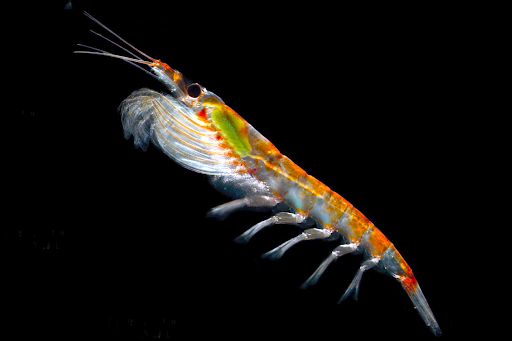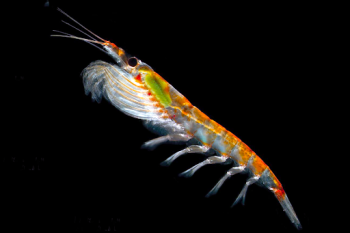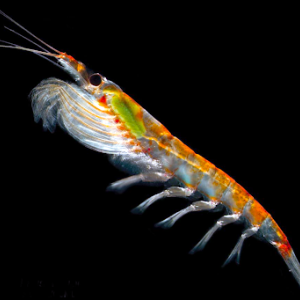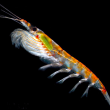Study looks at individual krill to explain group behavior
New research has found that the decisions made by individual Antarctic krill help to shape the massive schools they form, which can stretch for hundreds of miles.
The tendency of these shrimp-like crustaceans to aggregate into schools – an uncommon behavior among invertebrates – makes them an important food source for many larger animals, as well as a valuable fishery. The study found that individual krill respond to environmental cues, which provides insight into how their massive schools form and behave around the globe.
“Researchers typically try to understand how these animals school relative to external forces, like currents, deep water, and predators,” said David Fields, a senior research scientist at Bigelow Laboratory for Ocean Sciences and an author of the Polar Biology paper. “We’re instead looking inside the school to understand how each animal makes independent decisions that helps shape the group’s behavior.”
Fields and two scientists from the Georgia Institute of Technology used a novel approach to study Antarctic krill, which are the largest of 85 known species. By observing krill in an artificial water channel, the researchers found that animals’ swimming speed and direction changed in response to the scent of food and the speed of the water. Even very slight currents caused the krill to swim upstream, a behavior that allows them move and feed efficiently while also avoiding predators. The researchers believe that krill’s sensitivity to their environment allows them to swim coherently together in their extensive schools, drafting off one another like bicyclists in a peloton.
Krill are an essential link in Antarctic food webs, where they transfer energy from the tiny plants and animals they consume to the fish, seabirds, seals, and whales that eat them. Their tendency to aggregate makes them a crucial food source for large animals, who can make a meal out of the densely-packed groups. They play this important role in ecosystems around the globe, including the Gulf of Maine and as far north as the Arctic.
Their schooling behavior also makes them the target of major fisheries in both the Antarctic and the Arctic. Krill are key ingredients in nutritional supplements, aquaculture feed, fish bait, and animal feed. In recent years, several enzymes that krill produce have also gained scientists’ attention for medical applications.
Krill’s amazingly sophisticated schooling behavior has enabled their success while making them a primary player in food webs and a fishery with global importance,” Fields said. “Understanding their behavior more completely will help us manage populations of this pivotal animal and keep fishing to a sustainable level.”
Recent funding by the National Science Foundation will allow these researchers to continue exploring krill behavior by studying how the animals respond to light, dark, and the scent of one of their major predators – penguins. The team also plans to build a circular water channel that will allow them to observe how krill aggregation is influenced by flow and chemical signals. This will show how the animals orient themselves and respond to stimuli as a school, as well as what factors influence how tightly they group together.
“Evolution has honed krill to work together in order to thrive in challenging environments,” Fields said. “From observing single animals, we can learn about large-scale patterns that shape how the planet works.”
Event Date
Address
United States























